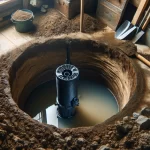Regular maintenance of a sump pump is crucial for several key reasons. Mainly, it is essential in preventing basement flooding and subsequent water damage. By ensuring that the pump is in optimal working condition, especially during heavy rainfall or snowmelt periods, you effectively safeguard your home against the destructive effects of water intrusion. Regular maintenance not only keeps the pump ready for immediate action but also significantly improves its efficiency in water management.
Table of Contents
Why is regular maintenance for the sump pump needed?
The longevity and performance of a sump pump are directly tied to how well it is maintained. A sump pump is subject to wear and tear like any mechanical equipment. You can prevent the gradual deterioration that often troubles neglected sump pumps through consistent maintenance checks and cleaning. This care extends the pump’s lifespan and bolsters its reliability. A well-maintained pump is far more likely to function without an issue when you need it most, such as during severe weather events. Additionally, regular cleaning is crucial in preventing clogs from dirt, debris, and small stones, which can otherwise hinder the pump’s performance.
Furthermore, sump pump maintenance is a cost-effective strategy. It preemptively addresses issues that could lead to the pump overworking and the motor burning out. Detecting and fixing such problems early on can prevent the need for costly repairs or even replacements in the future. Moreover, a well-maintained sump pump circumvents expensive home repairs by averting basement flooding. On a safety note, a malfunctioning sump pump can pose significant electrical hazards, particularly in flooding. Therefore, regular maintenance is not just about operational efficiency but also about ensuring the safety of your home environment.
Sump Pump Maintenance 101
- Keep the sump pit clean. Remove debris or sediment from the pit regularly to ensure the pump can function correctly.
- Check the sump pump regularly. Test the pump at least once a month by pouring a bucket of water into the sump pit and ensuring the pump turns on and pumps the water out.
- Check the check valve. Make sure the check valve functions properly and allows water to flow in only one direction. If the check valve is not working correctly, it can cause the pump to run continuously or fail to pump water out of the pit effectively.
- Clean the pump. If the pump appears to be running less efficiently, it may be clogged with debris. Carefully remove the pump from the sump pit and clean it according to the manufacturer’s instructions.
- Replace the pump if necessary. If the pump is old or damaged, it may need to be replaced to ensure it is functioning properly.
Good maintenance is the most crucial first step for your sump pump maintenance. By following these steps, you can help ensure that your sump pump functions correctly and does its job effectively.
Maintaining your sump pump is crucial to ensure the effectiveness of your home’s drainage system and prevent basement damage. Key maintenance steps include:
Regular Cleaning:
- Remove debris: Wear rubber gloves to clear out dirt and foreign objects that can clog the inlet screen.
- Use a garden hose to fill the pump, causing the float to rise and activate the pump. If the pump doesn’t start, it’s time for troubleshooting.
Troubleshooting:
- Consult your owner’s manual for specific troubleshooting steps.
- Check the electrical system: Unplug the pump and test the outlet with a working clock or lamp. Ensure the breaker is on.
- Reset the motor switch and check the float switch’s operation.
- If overused or clogged, the motor might burn out; verify its condition.
- Manually move the float switch up and down to clean dirty contacts.
Regular Maintenance:
- Replace the float switch frequently.
- If removable, consider repairing any damaged parts yourself.
By following these steps, outlined in most sump pump manuals, you can prevent common issues and ensure the longevity and efficiency of your sump pump.


